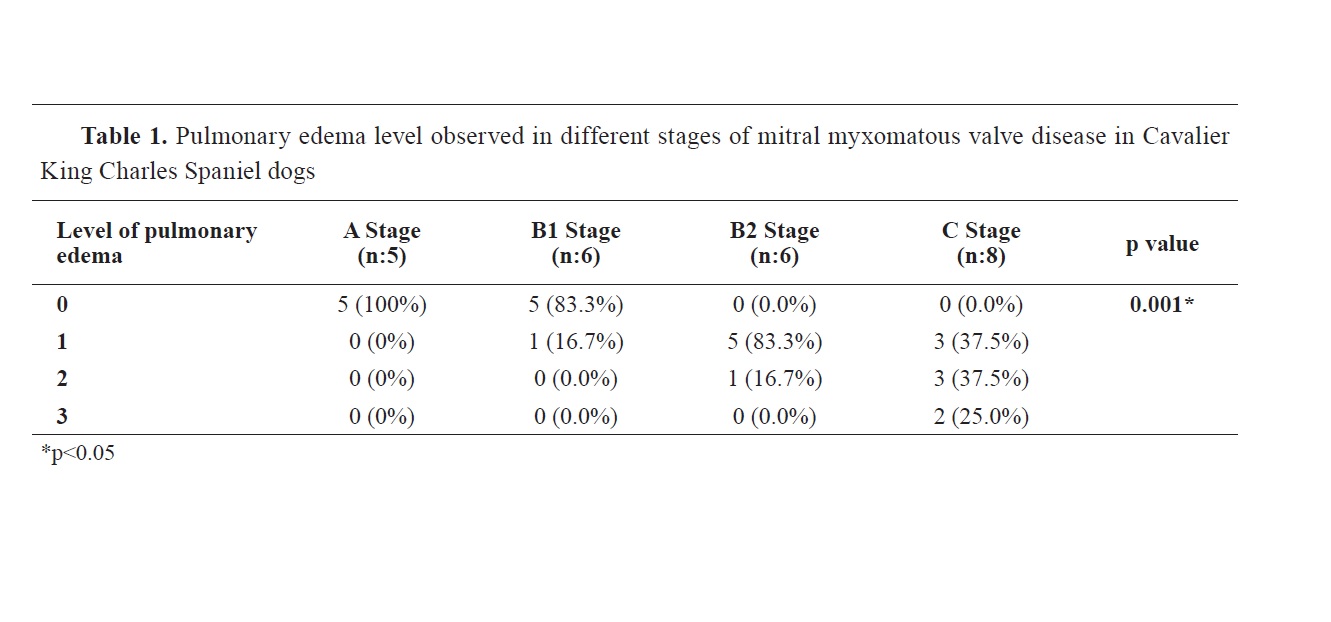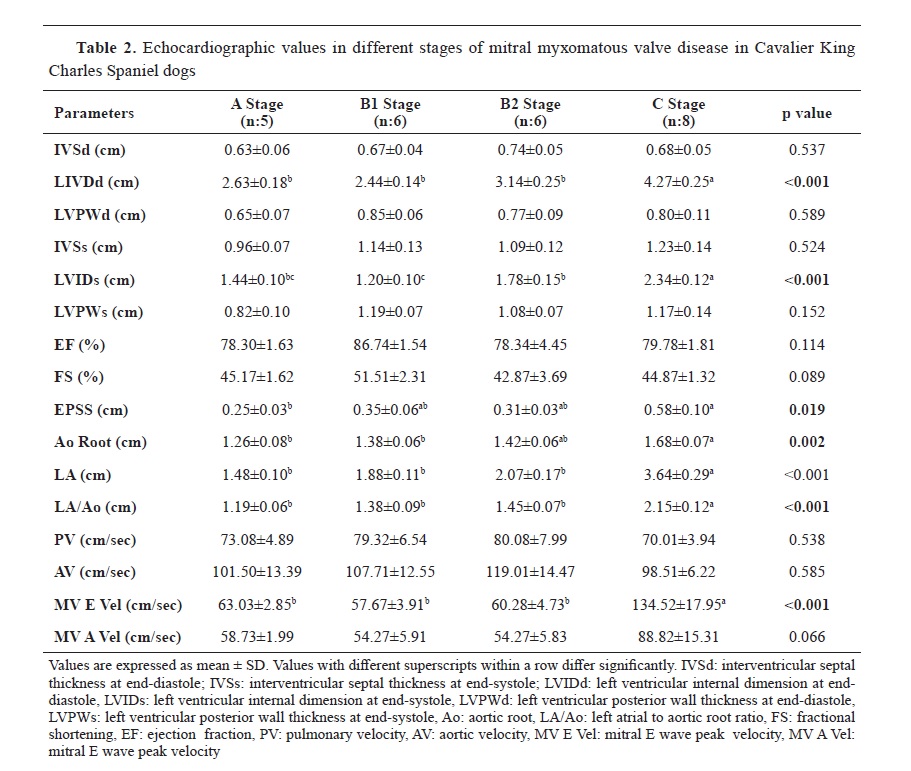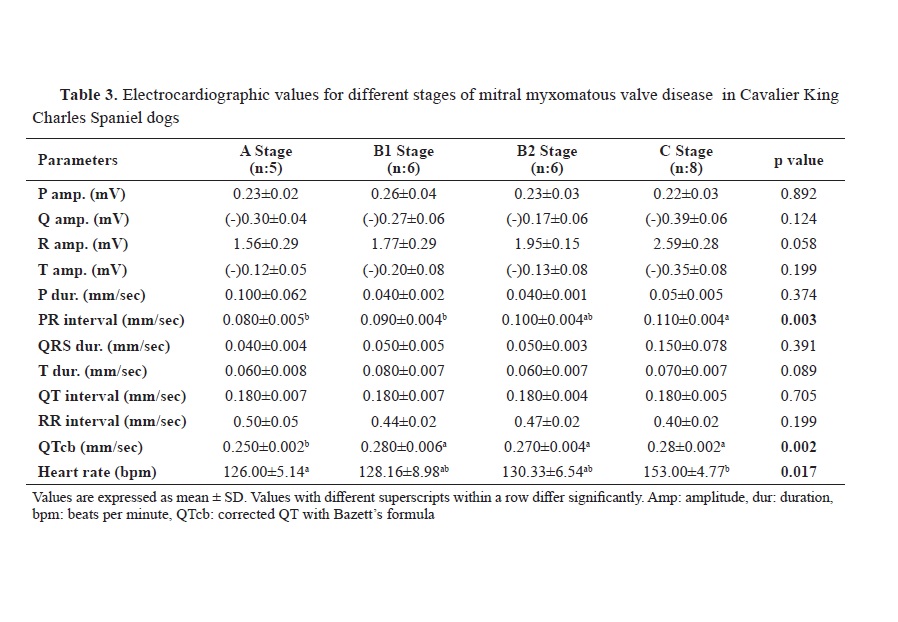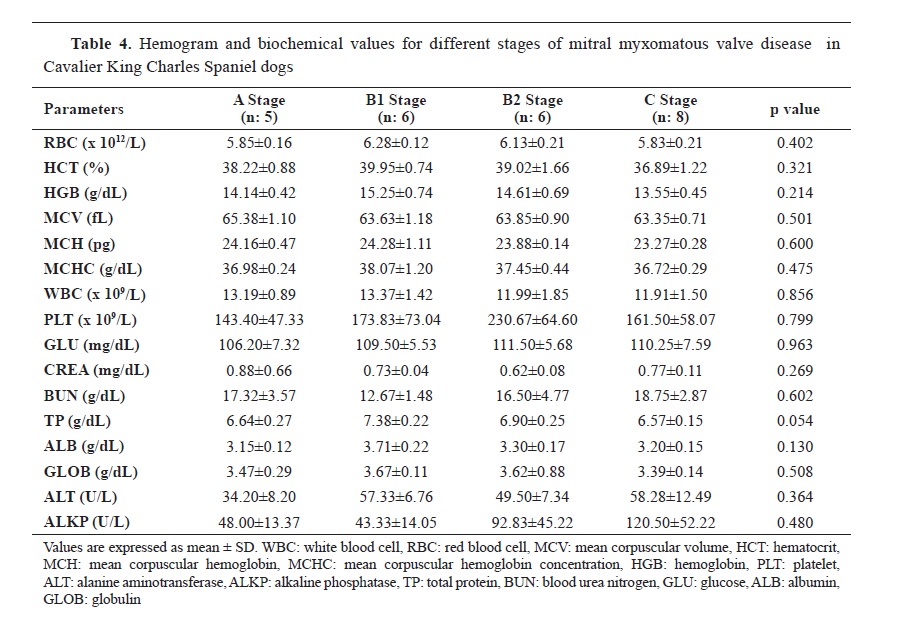2. Madsen, M.B., Olsen, L.H., Häggström, J., Höglund, K., Ljungvall, I., Falk, T., Wess, G., et al. (2011). Identification of 2 loci associated with development of myxomatous mitral valve disease in
5. Beardow, A.W., Buchanan, J.W. (1993). Chronic mitral valve disease in cavalier King Charles spaniels: 95 cases (1987-1991). J Am Vet Med Assoc. 203(7): 1023-1029.
6. Summers, J.F., O’Neill, D.G., Church, D.B., Thomson, P.C., McGreevy, P.D., Brodbelt, D.C. (2015). Prevalence of disorders recorded in Cavalier King Charles Spaniels attending primary-care veterinary practices in England. Canine Genet Epidemiol. 2, 4.
https://doi.org/10.1186/s40575-015-0016-7 PMid:26401332 PMCid:PMC4579365
7. Ljungvall, I., Ahlstrom, C., Höglund, K., Hult, P., Kvart, C., Borgarelli, M., Ask, P., Häggström, J. (2009). Use of signal analysis of heart sounds and murmurs to assess severity of mitral valve regurgitation attributable to myxomatous mitral valve disease in dogs. Am J Vet Res. 70(5): 604-613.
https://doi.org/10.2460/ajvr.70.5.604 PMid:19405899
8. Pomerance, A., Whitney, J.C. (1970). Heart valve changes common to man and dog: a comparative study. Cardiovasc Res. 4(1): 61-66.
https://doi.org/10.1093/cvr/4.1.61 PMid:5416844
9. Edwards, N.J. (1987). Balton’s handbook of canine and feline electrocardoigraphy (2nd ed.). Philadelphia: W.B. Saunders Co 10. Barr, C.S., Nass, A., Freeman, M., Lang, C.C., Struthers, A.D. (1994). QT dispersion and sudden unexpected death in chronic heart failure. Lancet. 343(8893): 327-329.
https://doi.org/10.1016/S0140-6736(94)91164-9 PMid:7905146
11. Viskin, S. (2009). The QT interval: too long, too short or just right. Heart Rhythm. 6(5): 711-715.
https://doi.org/10.1016/j.hrthm.2009.02.044 PMid:19389656
12. Gonul, R., Koenhemsi, L., Yildiz, K., Or, M.E. (2019). Determination of corrected QT interval in Kangal breed dogs. Pak Vet J. 39(1): 86-90.
https://doi.org/10.29261/pakvetj/2018.115 13. Oliveira, M.S., Muzzi, R.A.L., Muzzi, L.A.L., Cherem, M., Mantovani, M.M. (2014). QT interval in healthy dogs: which method of correcting the QT interval in dogs is appropriate for use in small animal clinics? Animal Morphophysiology. Pesq Vet Bras. 34(5): 469-472.
https://doi.org/10.1590/S0100-736X2014000500014 14. Phan, D.Q., Silka, M.J., Yueh-Tze, L., Lan, Y.T., Chang, R.K. (2015). Comparison of formulas for calculation of the corrected QT interval in infants and young children. J Pediatr. 166(4): 960-964.
https://doi.org/10.1016/j.jpeds.2014.12.037 PMid:25648293 PMCid:PMC4380641
15. Cobos Gil, M.A. (2013). A new, simpler and better correction formula for the QT interval. J Am Coll Cardiol. 61(10): E294.
https://doi.org/10.1016/S0735-1097(13)60294-6 16. Molnara, J., Weiss, J., Zhang, F., Rosenthal, J.E. (1996). Evaluation of five QT correction formulas using a software-assisted method of continuous QT measurement from 24-hour Holter recordings. Am J Card. 78(8): 920-926.
https://doi.org/10.1016/S0002-9149(96)00468-7 PMid:8888666
17. Bazett, H.C. (1920). An analysis of the time-relations of electrocardiograms. Heart 7, 353-370.
18. Buchanan, J.W. (2000). Vertebral scale system to measure heart size in radiographs. Vet Clin North Am Small Anim Pract. 30(2): 379-393.
https://doi.org/10.1016/S0195-5616(00)50027-819. Keene, B.W., Atkins, C.E., Bonagura, J.D., Fox, P.R., Häggström, J., Fuentes, V.L., Oyama, M.A., et al. (2019). ACVIM consensus guidelines for the diagnosis and treatment of myxomatous mitral valve disease in dogs. J Vet Intern Med. 33(3): 1127-1140.
https://doi.org/10.1111/jvim.15488 PMid:30974015 PMCid:PMC6524084
20. Häggström, J., Hansson, K., Kvart, C., Swenson, L. (1992). Chronic valvular disease in the cavalier King Charles spaniel in Sweden. Vet Rec. 131(24): 549-553.
21. Birkegard, A.C., Reimann, M.J., Martinussen, T., Häggström, J., Pedersen, H.D., Olsen, L.H. (2016). Breeding restrictions decrease the prevalence of myxomatous mitral valve disease in Cavalier King Charles Spaniels over an 8- to 10-year period. J Vet Intern Med. 30(1): 63-68.
https://doi.org/10.1111/jvim.13663 PMid:26578464 PMCid:PMC4913653
22. Borgarelli, M., Haggström, J. (2010). Canine degenerative myxomatous mitral valve disase: natural history, clinical presentation and therapy. Vet Clin Small Anim Pract. 40(4): 651-663.
https://doi.org/10.1016/j.cvsm.2010.03.008 PMid:20610017
23. Cho, E.J., Han, K., Lee, S.P., Shin, D.W., Yu, S.J. (2020). Liver enzyme variability and risk of heart disease and mortality: a nationwide populationbased study. Liver Int. 40(6): 1292-1302.
https://doi.org/10.1111/liv.14432 PMid:32153096
24. Nicholle, A.P., Chetboul, V., Allerheiligen, T., Pouchelon, J.L., Gouni, V., Tessier Vetzel, D., Lefebvre, H.P. (2007). Azotemia and glomerular filtration rate in dogs with chronic valvular disease. J Vet Intern Med. 21(5): 943-949.
https://doi.org/10.1111/j.1939-1676.2007.tb03047.x PMid:17939547
25. Isbister, G.K., Page, C.B. (2013). Drug induced QT prolongation: the measurement and assessment of the QT interval in clinical practice. Br J Clin Pharmacol. 76(1): 48-57.
https://doi.org/10.1111/bcp.12040 PMid:23167578 PMCid:PMC3703227
26. Gralinski, M.R. (2003). The dog’s role in the preclinical assessment of QT interval prolongation. Toxicol Pathol. 31: 11-16.
https://doi.org/10.1080/01926230390174887 PMid:12597426
27. Ether, N.D., Jantre, S.R., Sharma, D.B., Leishman, D.J., Bailie, M.B., Lauver, D.A. (2022). Improving corrected QT; Why individual correction is not enough. J Pharmacol Toxicol Methods. 113, 107126.
https://doi.org/10.1016/j.vascn.2021.107126 PMid:34655760
28. Dekker, J.M., Crow, R.S., Hannan, P.J., Schouten, E.G., Folsom, A.R. (2004). Heart rate-corrected QT interval prolongation predicts risk of coronary heart disease in black and white middle-aged men and women: the ARIC study. J Am Coll Cardiol. 43(4): 565-571.
https://doi.org/10.1016/j.jacc.2003.09.040 PMid:14975464
29. Patel, S., Bhatt, L., Patel, R., Shah, C., Patel, V., Patel, J., Sundar, R., et al. (2017). Identifiction of appropriate QTc Formula in beagle dogs for nonclinical safety assesment. Regul Toxicol Pharmacol. 89, 118-124.
https://doi.org/10.1016/j.yrtph.2017.07.026 PMid:28751260
30. Koyama, H., Yoshii, H., Yabu, H., Kumada, H., Fukuda, K., Mitani, S., Rousselot, J.F., et al. (2004). Evaluation of QT interval prolongation in dogs with heart failure. J Vet Med Sci. 66(9): 1107-1111.
https://doi.org/10.1292/jvms.66.1107 PMid:15472475
31. Batey, A.J., Doe, C.P.A. (2002). A method for QT correction based on beat-to-beat analysis of the QT/RR interval relationship in conscious telemetred beagle dogs. J Pharmacol Toxicol Methods. 48(1): 11-19.
https://doi.org/10.1016/S1056-8719(03)00009-1 PMid:12750037
32. Chiang, A.Y., Holdsworth, D.L., Leishman, D.J. (2006). A one-step approach to the analysis of the QT interval in conscious telemetrized dogs. J Pharmacol Toxicol Methods. 54(2): 183-188.
https://doi.org/10.1016/j.vascn.2006.02.004 PMid:16567113
33. Andršová, I., Hnatkova, K., Šišáková, M., Toman, O., Smetana, P., Huster, K.M., Barthel, P., et al. (2021). Infuence of heart rate correction formulas on QTc interval stability. Sci Rep. 11(1): 14269.
https://doi.org/10.1038/s41598-021-93774-9 PMid:34253795 PMCid:PMC8275798
34. Kmecova, J., Klimas, J. (2010). Heart rate correction of the QT duration in rats. Eur J Pharmacol. 641(2-3): 187-192.
https://doi.org/10.1016/j.ejphar.2010.05.038 PMid:20553920

 10.2478/macvetrev-2023-0014
10.2478/macvetrev-2023-0014



